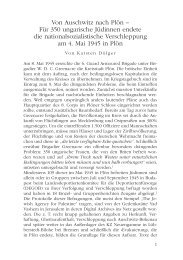The Kallos Family Book 2022
Always remember and tell the story to the world
Always remember and tell the story to the world
- TAGS
- barbara lorber
You also want an ePaper? Increase the reach of your titles
YUMPU automatically turns print PDFs into web optimized ePapers that Google loves.
PART 1: THE KALLOS FAMILY • 21
have this dance?’ By the time she was twelve,
Zoltan treated his daughter like a young lady.
Biri remembers he wore his sports jacket that
he wrapped around her while he taught her
the rhumba, foxtrot, tango, the Viennese and
English waltzes, and the Csárdása, a traditional
Hungarian folk dance. There was ample space
in the sitting room–dining area of their apartment
to conduct these lessons.
In the early 1940s, out of a total population
of 10,000, just over 2000 Jews lived in Técső
(formerly Ťačovo), mostly in harmony with
Christians. Today, only a few Jews live in what
is now called Tyachiv because most were murdered
in World War 2. Those few who did return
to look for surviving family soon left when, in
June 1945, Sub Carpathian Ruthenia ceded to
the Soviet Union.
German occupation
As Germany began to lose the war Hungary
tried to back out of its alliance and switch
sides. To stop them doing so, on 19 March 1944
the Germans unexpectedly occupied Greater
Hungary, arriving in Técső on Thursday, 23
March 1944, just one year before the Allied
victory and end of World War 2. This was a
disaster for the Hungarian Jews, who were the
last European Jewish community to succumb to
the Holocaust. The Germans were not a strong
presence in Técső; they didn’t need to be as the
Hungarian gendarmes, that is, the Hungarian
rural armed police force and Nazi collaborators,
happily did their dirty work for them.
Under German guidance, the Hungarian
puppet government passed an avalanche of
antisemitic laws that were enforced in Técső as
much as anywhere else. Jews suffered further
economic restrictions and their lives became
increasingly difficult, but Zoltan continued to
manage the Kallos Hotel for the Hungarian soldiers
and Wehrmacht (German army) as they
retreated through Técső from the advancing
Russians. A 6pm to 6am curfew was imposed on
Jews. Then, from early April 1944, Hungarian
Jews were forced to wear a yellow Star of David
badge, the size of a fist, on their clothing. Biri
recalls going to the town centre with her cousin
Babi before it too was declared out of bounds
to Jews. Each girl wore the Star of David on her
clothing. They were accompanied by a friendly
Hungarian officer (a rarity), Captain Zoltan
Fischer, who was staying at the Kallos Hotel.
He was very fond of Biri and bought her a small
cake from Katz Cukrászda (Katz Patisserie)
every day. He even offered to hide Biri in Budapest
with his mother but Zoltan and Lili refused
to be parted from their daughter. Besides, Biri
would not have gone anyway. After the war Biri
regretted having not tried to locate the soldier.
Even though the Germans living in the hotel
In early April 1944 all Hungarian Jews over the
age of 6 years, when outside their home, were
forced to wear a 10 x 10 cm canary yellow six
pointed cloth Star of David sewn onto the left
side of their outer garment. The details of the
star varied between Nazi occupied countries.
This is the one worn by Hungarian Jews.





